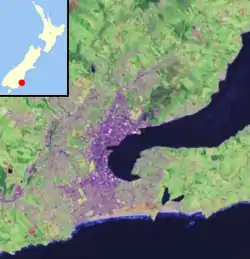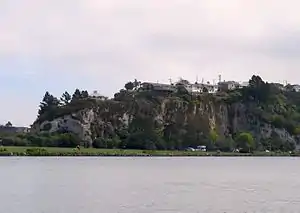Musselburgh, New Zealand
Musselburgh is a residential suburb of the New Zealand city of Dunedin. It is located in the southeast of the city's urban area, 2.8 kilometres (1.7 mi) southeast of the city's centre, and at the narrowest point of the isthmus which joins Otago Peninsula to the rest of the South Island (here just 1.5 kilometres (0.93 mi) in width). The suburb takes its name from the similarly named town in Scotland.[1] Musselburgh's 2001 population was 2,835.

Musselburgh's most distinctive feature is a rocky outcrop called the Musselburgh Rise, which rises prominently above the eastern end of "The Flat", the local name for the broad coastal plain which stretches across the suburbs of Saint Kilda and South Dunedin. The Rise is located close to the southernmost point of the Otago Harbour immediately to the west of the Andersons Bay Inlet. Another outcrop, geologically part of the same formation, lies several hundred metres to the east, and has been extensively quarried.
The rise lends its name to the suburb's main street, Musselburgh Rise (differentiated in name from the outcrop by always being written without the definite article), which connects with the southern end of Andersons Bay Road and skirts the southern flank of the outcrop. Musselburgh Rise contains the suburb's small retail area, consisting of some dozen or so shops. This shopping area and the southern flank of the Rise is sometimes considered a separate suburb, Sunshine, which was at one time known as Goat Hill.[2]

The northern side of the Musselburgh Rise is skirted by another main thoroughfare, Portobello Road. This road joins with the southern end of Portsmouth Drive close to the northeastern point of the rise, and continues across the causeway at Andersons Bay Inlet, though the junction is a limited one, and traffic may not turn right from the Musselburgh part of Portsmouth Drive to continue across the causeway. Close to the junction is a large memorial stone to the Taranaki Māori prisoners of the New Zealand Wars who were transported south to Dunedin, many of whom constructed the causeway and much of Dunedin's foreshore roads as forced labour.[3] A branch railway ran along Portobello Road in this area from the 1870s until 1912, and rail links continued to the suburb until the track were lifted in 1928.[4]
Close to the eastern edge of the rise is one of Dunedin's main secondary schools, Bayfield High School. This school lies close to the boundary of the suburbs of Musselburgh and Andersons Bay.
Musselburgh's residential area includes the top of the Musselburgh Rise, and spreads east and south along the eastern edge of the suburb of Saint Kilda. Other surrounding suburbs include Andersons Bay in the east, Tahuna in the southeast, and Tainui in the south. The top of the rise includes several larger homes, notably including Belmont, built in the 1860s for politician and newspaper editor William Cutten.[5] Belmont was later owned by Sidney Neill, and became famed for its gardens Neill was the son of Percy Neill, founder of Neill & Co, which was to become New Zealand's largest importer of spirits. Sidney Neill's widow lived at Belmont until the late 1950s when the large house was sold, divided and the property broken up into separate sections. The Rise was also home to Sir Norman Haggitt.
References
- Reed, A. W. (1975). Place names of New Zealand. Wellington: A. H. & A. W. Reed. ISBN 0-589-00933-8. p. 279
- Hayward, P. (1998) Intriguing Dunedin street walks. Dunedin: Express Office Services. p. 20>
- Hayward, P. (1998) Intriguing Dunedin street walks. Dunedin: Express Office Services. p. 23>
- "A brief history of Anderson's Bay". Retrieved 26 November 2010.
- Hayward, P. (1998) Intriguing Dunedin street walks. Dunedin: Express Office Services. p. 31>
External links
![]() Media related to Musselburgh, New Zealand at Wikimedia Commons
Media related to Musselburgh, New Zealand at Wikimedia Commons